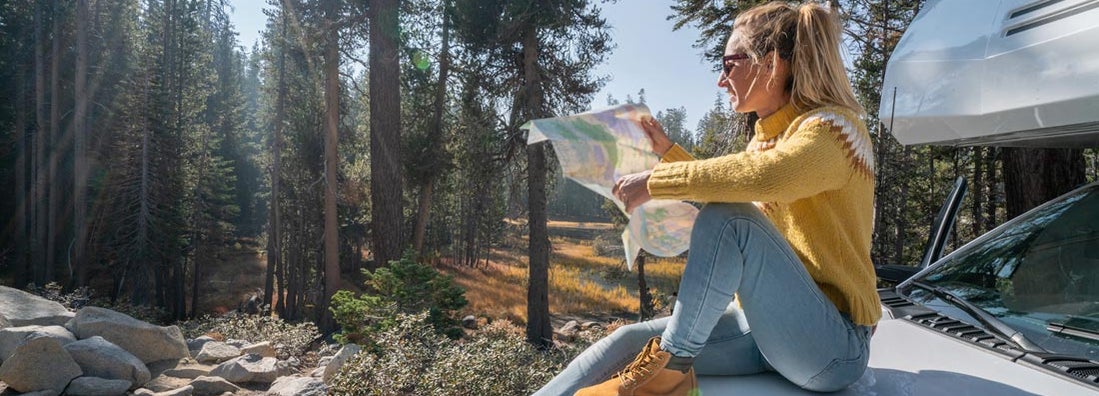Your Guide to RV Safety and Insurance

Andrew Flueckiger in an insurance writer for TrustedChoice.com. He's a licensed insurance agent who has earned his CIC designation and has written extensive insurance articles for many publications.

RVs have been a staple of American culture for a long time, and with good reason. Adding a small apartment or motel room to the back of your vehicle is American ingenuity at its finest.
But combining a living room with a vehicle that can travel 75 mph also poses its risks that are unique to other types of vehicles. You’ll want to put extra effort into making sure your RV is safe and well maintained at all times. And you’ll also want the proper type of insurance on it to protect your investment if something goes wrong.
What Does RV Insurance Cover?
RV insurance is very similar to your regular car insurance, but there are some key differences that apply specifically to RVs. There are three main types of RVs that qualify for RV insurance:
- Class A: These RVs can be up to 75 feet long and can generally include models like luxury coaches, converted buses, or motor coaches. They are the biggest type of RV on the road.
- Class B: These RVs are typically converted vans or camper vans and usually weigh no more than 9,000 pounds.
- Class C: This style of RV is basically a midsize. Usually they use a pickup truck chassis and can be up to 30 feet long.
As far as your insurance policy options are concerned, RV insurance can include all or some of the following insurance coverage options, many of which resemble car insurance:
- Liability: Liability pays if you’re responsible for somebody else’s injuries or property damages. RV insurance liability limit options are the same as car insurance options but they can be a different amount than what you have on your car insurance policy. You can buy as low as state minimum liability up to $500,000 or $1 million in liability coverage.
- Uninsured/underinsured motorist: If you’re involved in an accident and it’s the other person’s fault, but they either don’t have any insurance or they don’t have high enough liability limits to fully pay for your injuries, this coverage kicks in and can pay the difference.
- Comprehensive: Putting comprehensive coverage on your RV will insure it for things like theft, fire, wind damage, hail damage, falling objects, running into an animal, and almost anything else that could suddenly and accidentally damage your vehicle.
- Collision: Collision provides coverage on your own RV if it’s damaged during a wreck with another vehicle or solid object, such as a tree or building.
- Medical payments: This provides money to cover injuries that you or anyone in your RV might suffer during an accident, regardless of who is at fault.
- Roadside assistance: Many insurance companies offer roadside assistance coverage through a specific provider, meaning you’ll have a number to call if you need help on the road and the cost will either be fully or partially covered. Other companies don’t provide the number of a roadside assistance company, but will reimburse you after you pick a company and call one for help.
- Personal contents: Contents with RV insurance are slightly different than with auto insurance. Many people permanently keep contents in their RVs all year round, especially in Class A RVs. You can insure these contents on your RV policy, which allows you to avoid filing a claim on your homeowners insurance and you’ll likely have a lower deductible on your RV policy’s contents coverage than you would on your homeowners insurance.
- Pet injury coverage: If you’re going to be traveling with a pet, you can add pet injury coverage to your RV insurance policy. This typically pays around $1,000 for vet bills if your pet gets injured while in the RV, without a deductible.
Depending on which insurance company you’re dealing with, you may have more or less coverage options available. Your insurance policy will also partly depend on how you’re using your RV and how it’s being stored when not in use.
RV Safety Inspection
Most states have laws that require RVs to be inspected before they are able to hit the road, but there are two main types of RV inspections: state mandated safety inspections and comprehensive inspections.
- State mandated safety inspections: These safety inspections focus solely on whether or not the RV is safe to travel on the road, but mainly focus on the frame of the vehicle.
- Comprehensive or pre-purchase inspection: These inspections go into greater detail on your RV, including a check on it’s engine and fluids, and possibly even lab tests for water storage tanks.
RV Child Safety
One danger of RVing is forgetting that it’s a vehicle. It’s tempting to think that the spacious interiors are completely safe, because they resemble a small room as opposed to a moving vehicle.
But not properly restraining any passengers, including children, can put their wellbeing and their life at risk if you get into an accident. An unrestrained child in a vehicle moving 60 mph is at great risk of serious injury, or even death, especially considering that there might be other unrestrained things in the back that could cause further injury.
It’s also best to have the proper safety seating in place in your RV, just as if your kids were sitting in the back seat of a car. This includes booster seats and car seats being used in forward-facing seats. Make sure that whatever your child’s seat is attached to is very secure, and ideally isn’t right next to anything that could fall onto your child.
Standard factory built benches and seatbelts in RVs are sometimes not up to the highest safety standards, so you may want to do a little extra work on your RV to make it more safe for traveling children.
RV Pet Safety
Taking your pets with you in your RV can pose extra work and challenges if you’re not prepared. Whatever type of pet you have, your pet will be better able to adjust to a long road trip in the RV if they can get used to it first, so you may want to take your pet with you on short trips first.
Short trips with your pet will make your pet more comfortable in your RV and will also help you know what you need to do to prepare for a long journey with your pet.
The safety of your pet is just as important as making them comfortable, so it’s always best to secure your pet inside a carrier, crate, or harness while traveling. If you don’t secure your pet, there is a good chance that the pet will either become injured while traveling or cause damage to the interior of your RV.
Safety Alert Carbon Monoxide Detectors for RVs
Carbon monoxide is of particular concern to RV owners because there’s a greater chance of CO entering your cabin than with a regular vehicle. Carbon monoxide, or CO, is a product of fuel being burned, but because of the larger nature of RVs, it can more readily enter the cabin and cause serious injury or death, particularly because it has no taste, smell, or sight.
It’s always advised to purchase a carbon monoxide detector that’s separate from a smoke detector. You’ll want both for your RV, in addition to an LP-gas detector. The location of these detectors is important as well, because each gas type acts slightly differently and is either heavier or lighter than normal air. So you’ll want to put each detector where it’s best suited to first detect any hint of smoke or gas.
RV Tire Safety
Tire blowouts can cause more damage to an RV than they can cause to a car, due to the bigger size of RVs. Tires can last a long time but it’s important to remember that they don’t last forever, and to routinely check them, especially while traveling.
Here are some additional tire safety tips:
- Check your tire pressure frequently when you’re on the road.
- Inflate your tires prior to putting your RV in storage.
- Cover your tires if you’re storing your RV outside for prolonged periods of time, as prolonged sunlight can damage the tires.
- Remove heavy items from your RV prior to storage to reduce the load on the tires.
- Immediately clean off any oil from your tires using soap and water, not a solvent.
The Benefits of an Independent Insurance Agent
Placing the proper insurance cover on your RV is what an independent insurance agent excels in. They know the different coverage options and can work with you to find the best coverage at the best price. An independent insurance agent has access to multiple companies and can look at whether putting your RV with your current car insurance company is the best option, or whether buying a stand-alone policy makes more sense.
http://www.funroads.com/rv-travel/safety/checklist/
http://www.sharetheroadsafely.org/cardrivers/RVSafety_Tips.asp
http://www.dmv.org/how-to-guides/rv-handling.php
http://www.funroads.com/rv-travel/safety/overloaded/